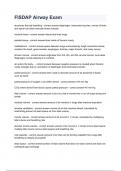-
1. Exam (elaborations) - Paramedic fisdap final questions & answers
-
2. Exam (elaborations) - Paramedic fisdap final with complete solution
-
3. Exam (elaborations) - Paramedic fisdap final exam mega review, all study guides questions & answers
-
4. Exam (elaborations) - Paramedic fisdap final with complete solution
-
5. Exam (elaborations) - Paramedic fisdap final questions & answers
-
6. Exam (elaborations) - Paramedic fisdap airway final review questions & answers
-
7. Exam (elaborations) - Paramedic fisdap airway exam questions & answers
-
8. Exam (elaborations) - Paramedic fisdap airway exam questions & answers
-
9. Exam (elaborations) - Paramedic fisdap airway final review questions & answers
-
10. Exam (elaborations) - Emt fisdap airway exam review questions & answers
-
11. Exam (elaborations) - Emt fisdap airway exam questions & answers
-
12. Exam (elaborations) - Fisdap/nremt respiratory practice questions & answers
-
13. Exam (elaborations) - Emt fisdap final with complete solution
-
14. Exam (elaborations) - Fisdap airway exam questions & answers
-
15. Exam (elaborations) - Fisdap airway exam questions & answers
-
16. Exam (elaborations) - Fisdap airway exam questions & answers
-
17. Exam (elaborations) - Fisdap airway exam mid east with complete solution
-
18. Exam (elaborations) - Fisdap study guide (airway) with complete solution
-
19. Exam (elaborations) - Fisdap paramedic final 2022 with complete solution
-
20. Exam (elaborations) - Fisdap final with complete solution
-
21. Exam (elaborations) - Fisdap airway study guide questions & answers
-
22. Exam (elaborations) - Fisdap airway study guide questions & answers
-
23. Exam (elaborations) - Fisdap airway practice quiz questions & answers
-
24. Exam (elaborations) - Fisdap airway exam questions & answers
-
25. Exam (elaborations) - Fisdap airway exam study guide questions & answers
-
26. Exam (elaborations) - Fisdap airway exam review questions & answers
-
27. Exam (elaborations) - Fisdap paramedic final 2022 all verified questions with complete solutions
-
28. Exam (elaborations) - Fisdap readiness 2 remediation 2023
-
29. Exam (elaborations) - Fisdap readiness, fisdap readiness
-
30. Exam (elaborations) - Paramedic fisdap final with complete solution
-
31. Exam (elaborations) - Fisdap readiness 2 remediation 2023 with complete solution
-
32. Exam (elaborations) - Fisdap readiness, fisdap readiness with complete solution
-
33. Exam (elaborations) - Fisdap airway exam with complete solution
-
34. Exam (elaborations) - Fisdap airway exam study guide with complete solution
-
35. Exam (elaborations) - Fisdap airway exam with complete solution
-
36. Exam (elaborations) - Paramedic fisdap airway exam
-
37. Exam (elaborations) - Fisdap airway practice quiz with complete solution
-
38. Exam (elaborations) - Fisdap airway exam with complete solution
-
39. Exam (elaborations) - Emt fisdap airway exam with complete solution
-
40. Exam (elaborations) - Fisdap airway exam with complete solution
-
41. Exam (elaborations) - Fisdap airway study guide with complete solution
-
42. Exam (elaborations) - Fisdap/nremt respiratory practice questions
-
43. Exam (elaborations) - Fisdap study guide (airway) all questions with complete solution.
-
44. Exam (elaborations) - The best fisdap airway study guide with complete solution
-
45. Exam (elaborations) - Fisdap airway exam review all questions with complete solution.
-
46. Exam (elaborations) - Fisdap airway exam mid east all questions with complete solution.
-
47. Exam (elaborations) - Fisdap airway study guide with complete solution
-
48. Exam (elaborations) - Emt fisdap airway exam review with complete solution
-
49. Exam (elaborations) - Paramedic fisdap final with complete solution
-
50. Exam (elaborations) - Paramedic fisdap final all questions with complete solution.
-
51. Exam (elaborations) - Fisdap paramedic final 2022 with complete solution
-
52. Exam (elaborations) - Paramedic fisdap final with complete solution
-
53. Exam (elaborations) - Paramedic fisdap final with complete solution
-
54. Exam (elaborations) - Paramedic fisdap final exam mega review, all study guides
-
55. Exam (elaborations) - Fisdap final with complete solution
-
56. Exam (elaborations) - Emt fisdap final all questions with complete solution.
-
57. Exam (elaborations) - Paramedic fisdap airway final review all questions with complete solution.
-
Show more




